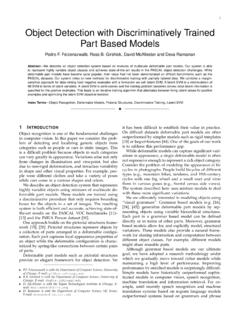Transcription of BUSINESS MODEL - integratedreporting.org
1 1 BUSINESS MODELBACKGROUND PAPER FOR <IR>2 BUSINESS MODEL BACKGROUND PAPER FOR <IR> The Technical Task Force of the International Intergrated Reporting Council (IIRC) established a Technical Collaboration Group (TCG) to prepare this Background Paper for <IR>. The TCG was coordinated by the lead organizations with input from participants from a range of disciplines and countries. This paper reflects the collective views of TCG participants, not necessarily those of their organizations or the IIRC. The IIRC considered interim findings from the TCG when preparing the Prototype Framework released in November 2012, and is further considering this paper in developing a Consultation Draft of the International Integrated Reporting (<IR>) Framework.
2 This paper provides background information that will assist stakeholders when responding to the Consultation Draft. The IIRC gratefully acknowledges the contributions made by the following in the drafting of this Background Paper for <IR>:LEAD ORGANIZATIONS Chartered Institute of Management Accountants (CIMA) International Federation of Accountants (IFAC) PricewaterhouseCoopers (PwC)PROJECT TEAM Stathis Gould, IFAC Mark O Sullivan, PwC Charles Tilley, CIMA Nick Topazio, CIMASTEERING GROUP Ralf Frank, Deutsche Vereinigung f r Finanzanalyse und Asset Management Lisa French, IIRC Alan Knight, Taylor Knight David Matthews, KPMG Michael Nugent, IIRC (International Federation of Accountants)
3 Alan Teixeira, International Accounting Standards BoardCopyright March 2013 by the International Integrated Reporting Council. All rights reserved. Permission is granted to make copies of this work to achieve maximum exposure provided that each copy bears the following credit line: Copyright March 2013 by the International Integrated Reporting Council. All rights reserved. Used with permission of the International Integrated Reporting Council. Permission is granted to make copies of this work to achieve maximum : 2052-1723 CONTENTS1 Executive summary21.
4 Introduction2 1A About this Paper2 1B Methodology22. Research2 2A Literature review4 2B Current practice5 2C Implications for the Framework63. Definition74. Positioning the BUSINESS MODEL 85. Relationship to the capitals106. Reporting11 6A Reporting on inputs13 6B Reporting on BUSINESS activities13 6C Reporting on outputs13 6D Reporting on outcomes13 6E Enhancing effectiveness and readability14 6F Organizations with multiple BUSINESS models 15 Appendix Literature review1 BUSINESS ModelBackground Paper for <IR>Executive summary At the heart of an organization is its chosen BUSINESS MODEL .
5 Current BUSINESS MODEL reporting is inconsistent, both in terms of uptake and scope. Uptake appears to be influenced by the presence of regional legislation, corporate governance codes and listing requirements. Scoping inconsistencies are linked to mixed interpretations of what, exactly, constitutes a BUSINESS MODEL . This Background Paper for <IR> explores and reconciles divergent approaches in BUSINESS MODEL reporting with the aim of reaching a common, widely-accepted definition of the BUSINESS MODEL for use in Integrated Reporting (<IR>).
6 Specific implications for the development of the International <IR> Framework are as summarized below. A distinction is made between BUSINESS MODEL disclosures and other information such as: external factors or context capitals governance strategy and resource allocation opportunities and risks performance future outlook These elements are highly interconnected as shown below: The term BUSINESS MODEL is defined herein as the chosen system of inputs, BUSINESS activities, outputs and outcomes that aims to create value over the short, medium and long term.
7 Consideration of inputs, outputs and outcomes will help to clarify the organization s positive and negative impacts on financial, manufactured, human, intellectual, natural and social and relationship capital. Such considerations will also encourage the organization to take a broader view of the concept of value creation. A distinction is made between outputs and outcomes. Outputs are the key products or services that an organization produces, as well as the waste or other by-products that create or erode value. Outcomes are the internal and external consequences for the capitals as a result of an organization s BUSINESS activities and outputs.
8 Assessing desired outcomes against actual performance and strategic objectives may prompt changes to the BUSINESS MODEL . OrganizationExternal environmentManufactur edIntellectualHumanSocial and relationshipNaturalFinancial SocietyFinancialManufactur edIntellectualHumanSocial and relationshipNaturalSocietyOrganizationMi ssion and vision GovernanceOpportunitiesand risksStrategy andresource allocationFuture outlookPerformanceBusinessactivitiesOutp utsInputsOutcomesBusiness model21. Introduction1. The term BUSINESS MODEL was used extensively in the IIRC s September 2011 Discussion Paper, Towards Integrated Reporting Communicating Value in the 21st Century 1, where it was identified as one of two central themes for the future direction of reporting.
9 2 The Discussion Paper noted that although there is no single, generally accepted definition of the term BUSINESS MODEL .. it is often seen as the process by which an organization seeks to create and sustain value. 2. In the Prototype of the International <IR> Framework (Prototype Framework) released in November 2012,3 the BUSINESS MODEL was discussed as a fundamental concept and reporting on the BUSINESS MODEL was identified as a Content Element that should be included in any integrated report. This is consistent with one of the aims of Integrated Reporting <IR>, as noted in the Discussion Paper, to facilitate a meaningful assessment of the long-term viability of the organization s BUSINESS MODEL and strategy.
10 3. The emphasis on the BUSINESS MODEL as a reportable element reflects the view that one of the key starting points for an investor s analysis should be an organization s BUSINESS MODEL and how it relates to the organization s strategy, governance, performance and The IIRC s summary of Discussion Paper responses4 shows that a majority of respondents agreed that the BUSINESS MODEL is an appropriate central theme for <IR> but requested that a common definition be developed. Respondents were also interested in better understanding the connection between the BUSINESS MODEL and the concepts of multiple capitals and value creation as used in the Discussion 1A About this Paper5.





